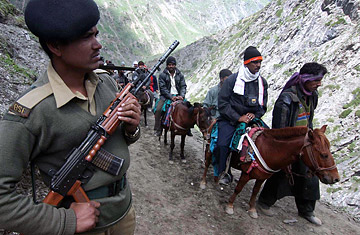
Indian Hindu devotees ride horses past a soldier on their way to the holy Amarnath Cave.
High up in the stunning Kashmir Valley lies a natural cave called Amarnath, where stalagmites form during the summer months. Devout Hindus believe this cave to be one of the holiest sites of their religion, and that the largest of the ice formations is a Shiva Lingam, the symbol of Lord Shiva. Hindu mythology has it that Shiva — the destroyer in the Hindu Trinity that includes Brahma the creator and Vishnu the preserver — imparted the secrets of creation to his consort, Parvati, in Amarnath. Each year, during the months of July and August, hundreds of thousands of Hindu pilgrims from across India and abroad take an arduous five-day, 40-mile trek to worship at this cave.
The only trouble at the cave used to be that the Shiva Lingam would melt before the greater part of the throngs could arrive to pay obeisance (The stalagmite does wax and wane with the seasons but some blame premature melting on global warming, others on heightened human activity near the shrine). However, for more than two months now, this small, 150 ft high and 90 ft long cave has been the center of a raging communal and political storm in the state of Jammu and Kashmir — one that has divided the Hindu and Muslim populations of the state. Now, the Hindu rightwing Bharatiya Janata Party is all set to make it a major issue leading up to the general elections next year, with potentially explosive results.
The cave is a gigantic challenge to managing the logistics of the pilgrimage — not only is it perched 4,000 meters (12,000 ft) above sea level where rain, snow and landslides are common, it is also plunk in the middle of the insurgency-ravaged Kashmir Valley. And with ever greater numbers of pilgrims coming in (so far this year, over 500,000 pilgrims have already visited) the government reasoned that more temporary shelters were required. And so on May 26 the ruling Congress-led government of Jammu and Kashmir decided to divert 100 acres of forest land to erect such facilities for Hindu pilgrims.
Muslim hardliners complained vehemently against what they alleged was an attempt to create "Israel-like" settlements of Hindus to change the demography of the Muslim-majority Kashmir Valley. (It would be a daunting feat for even the most fanatical of such alleged settlers — the area is uninhabitable for much ofthe year.) But once the fears spread, protests in Kashmir grew. The government eventually backed down and revoked the shelter order on July 1. That, in turn, led to a backlash from Hindus in the Hindu-majority Jammu region of the state, with right-wing parties including the BJP jumping in to protest against what they alleged was capitulation to "Muslim separatists."
Since then, protests have engulfed many parts of the state, with demonstrators clashing with the police in what many say is the largest mass agitation in the state since the 1990s, when the insurgency was raging. This week, at least three protestors have been killed and scores injured. On Tuesday, Hindu protesters blocked traffic on the main highway, leaving the Valley short of food, fuel and medical supplies, and leaving Kashmiri fruit-growers seeing their produce rotting instead of heading for markets in the rest of India.
The situation has come as a political bonanza for the BJP. In the last state elections in 2002, it had been wiped out in its stronghold of Jammu by the Congress Party. It has since been quick to grab the opportunity to both incite and tap Hindu anger. To many, it is reminiscent of the party's actions in Ayodhya in the late 1980s and early 1990s. The Hindu hardline party first shot to national prominence in the 1990s after it led public heated public demonstrations over a 16th century mosque in the north Indian town of Ayodhya, which they insisted was the birthplace of the Hindu deity Ram. Those demonstrations led to the worst outbreak of sectarian violence since the 1947 Partition that created India and Pakistan. The party has been at the forefront of Amarnath controversy in Jammu, and with its announcement that it will undertake nationwide strikes over the issue, it is set to make Shiva's cave a presence in the general elections.
Ironically, the Amarnath cave has long been one of many symbols of Hindu-Muslim camaraderie. Legend has it that the cave was discovered by a Muslim shepherd, and Muslim vendors benefited from the religious tourism for years until 2000, when the cave was put under the authority of the government-run Shri Amarnathji Shrine Board, the agency in charge of the shelters for pilgrims. Now, commentators see political opportunism at work across the political spectrum, not just the BJP. The move by the state's Congress government to allot 100 acres of forest land to the SASB, just months before elections due in October, was seen by many as aimed at attracting Hindu votes in the Hindu-majority Jammu part of the state. It clearly did not foresee the backlash. Meanwhile, the All Parties Hurriyat Conference, an alliance of secessionist leaders and parties, has announced a campaign to boycott the forthcoming state elections.
Manoj Joshi, author of Lost Rebellion: Kashmir in the 1990s, says all parties are equally to blame for dividing the state along religious lines. "And by blockading the Valley, they [Hindu hardliners] are making the Muslims more insecure and making them lean towards Pakistan." Joshi says, "It is a very dangerous game. One wonders how far they can go on playing with national interest."
